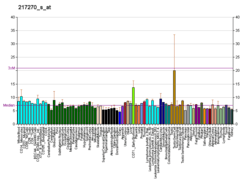DYRK1B
Dual specificity tyrosine-phosphorylation-regulated kinase 1B is an enzyme that in humans is encoded by the DYRK1B gene.[5][6]
Function
DYRK1B is a member of the DYRK family of protein kinases. DYRK1B contains a bipartite nuclear localization signal and is found mainly in muscle and testis. The protein is proposed to be involved in the regulation of nuclear functions. Three isoforms of DYRK1B have been identified differing in the presence of two alternatively spliced exons within the catalytic domain.[6]
Interactions
DYRK1B has been shown to interact with:
Clinical significance
One lone missense mutation in Dyrk1B gene (R102C) was found associated with an autosomal dominant early onset Coronary Artery Disease, juvenile-onset truncal obesity, severe hypertension, and type II diabetes mellitus - seen in subjects from a nomadic group in Iran.[9]
References
- 1 2 3 ENSG00000281320 GRCh38: Ensembl release 89: ENSG00000105204, ENSG00000281320 - Ensembl, May 2017
- 1 2 3 GRCm38: Ensembl release 89: ENSMUSG00000002409 - Ensembl, May 2017
- ↑ "Human PubMed Reference:".
- ↑ "Mouse PubMed Reference:".
- ↑ Leder S, Weber Y, Altafaj X, Estivill X, Joost HG, Becker W (Feb 1999). "Cloning and characterization of DYRK1B, a novel member of the DYRK family of protein kinases". Biochem Biophys Res Commun. 254 (2): 474–9. doi:10.1006/bbrc.1998.9967. PMID 9918863.
- 1 2 "Entrez Gene: DYRK1B dual-specificity tyrosine-(Y)-phosphorylation regulated kinase 1B".
- ↑ Lim S, Jin K, Friedman E (Jul 2002). "Mirk protein kinase is activated by MKK3 and functions as a transcriptional activator of HNF1alpha". J. Biol. Chem. 277 (28): 25040–6. doi:10.1074/jbc.M203257200. PMID 11980910.
- ↑ Zou Y, Lim S, Lee K, Deng X, Friedman E (Dec 2003). "Serine/threonine kinase Mirk/Dyrk1B is an inhibitor of epithelial cell migration and is negatively regulated by the Met adaptor Ran-binding protein M". J. Biol. Chem. 278 (49): 49573–81. doi:10.1074/jbc.M307556200. PMID 14500717.
- ↑ Keramati AR; et al. (2013). "Identification of a Novel Disease Gene for Early Onset Atherosclerosis, Diabetes and Metabolic Syndrome by Whole Exome Sequencing and Linkage Analysis". Circulation. 128 (22 Supplement).
Further reading
- Mercer SE, Friedman E (2006). "Mirk/Dyrk1B: a multifunctional dual-specificity kinase involved in growth arrest, differentiation, and cell survival". Cell Biochem. Biophys. 45 (3): 303–15. doi:10.1385/CBB:45:3:303. PMID 16845176.
- Lee K, Deng X, Friedman E (2000). "Mirk protein kinase is a mitogen-activated protein kinase substrate that mediates survival of colon cancer cells". Cancer Res. 60 (13): 3631–7. PMID 10910078.
- Lim S, Jin K, Friedman E (2002). "Mirk protein kinase is activated by MKK3 and functions as a transcriptional activator of HNF1alpha". J. Biol. Chem. 277 (28): 25040–6. doi:10.1074/jbc.M203257200. PMID 11980910.
- Lim S, Zou Y, Friedman E (2003). "The transcriptional activator Mirk/Dyrk1B is sequestered by p38alpha/beta MAP kinase". J. Biol. Chem. 277 (51): 49438–45. doi:10.1074/jbc.M206840200. PMID 12384504.
- Zou Y, Lim S, Lee K, Deng X, Friedman E (2004). "Serine/threonine kinase Mirk/Dyrk1B is an inhibitor of epithelial cell migration and is negatively regulated by the Met adaptor Ran-binding protein M.". J. Biol. Chem. 278 (49): 49573–81. doi:10.1074/jbc.M307556200. PMID 14500717.
- Skurat AV, Dietrich AD (2004). "Phosphorylation of Ser640 in muscle glycogen synthase by DYRK family protein kinases". J. Biol. Chem. 279 (4): 2490–8. doi:10.1074/jbc.M301769200. PMID 14593110.
- Brill LM, Salomon AR, Ficarro SB, Mukherji M, Stettler-Gill M, Peters EC (2004). "Robust phosphoproteomic profiling of tyrosine phosphorylation sites from human T cells using immobilized metal affinity chromatography and tandem mass spectrometry". Anal. Chem. 76 (10): 2763–72. doi:10.1021/ac035352d. PMID 15144186.
- Deng X, Ewton DZ, Mercer SE, Friedman E (2005). "Mirk/dyrk1B decreases the nuclear accumulation of class II histone deacetylases during skeletal muscle differentiation". J. Biol. Chem. 280 (6): 4894–905. doi:10.1074/jbc.M411894200. PMID 15546868.
- Mercer SE, Ewton DZ, Deng X, Lim S, Mazur TR, Friedman E (2005). "Mirk/Dyrk1B mediates survival during the differentiation of C2C12 myoblasts". J. Biol. Chem. 280 (27): 25788–801. doi:10.1074/jbc.M413594200. PMC 1201501. PMID 15851482.
- Rual JF, Venkatesan K, Hao T, Hirozane-Kishikawa T, Dricot A, Li N, Berriz GF, Gibbons FD, Dreze M, Ayivi-Guedehoussou N, Klitgord N, Simon C, Boxem M, Milstein S, Rosenberg J, Goldberg DS, Zhang LV, Wong SL, Franklin G, Li S, Albala JS, Lim J, Fraughton C, Llamosas E, Cevik S, Bex C, Lamesch P, Sikorski RS, Vandenhaute J, Zoghbi HY, Smolyar A, Bosak S, Sequerra R, Doucette-Stamm L, Cusick ME, Hill DE, Roth FP, Vidal M (2005). "Towards a proteome-scale map of the human protein-protein interaction network". Nature. 437 (7062): 1173–8. doi:10.1038/nature04209. PMID 16189514.
- Deng X, Ewton DZ, Li S, Naqvi A, Mercer SE, Landas S, Friedman E (2006). "The kinase Mirk/Dyrk1B mediates cell survival in pancreatic ductal adenocarcinoma". Cancer Res. 66 (8): 4149–58. doi:10.1158/0008-5472.CAN-05-3089. PMID 16618736.
- Takahashi-Yanaga F, Mori J, Matsuzaki E, Watanabe Y, Hirata M, Miwa Y, Morimoto S, Sasaguri T (2007). "Involvement of GSK-3beta and DYRK1B in differentiation-inducing factor-3-induced phosphorylation of cyclin D1 in HeLa cells". J. Biol. Chem. 281 (50): 38489–97. doi:10.1074/jbc.M605205200. PMID 17046823.





